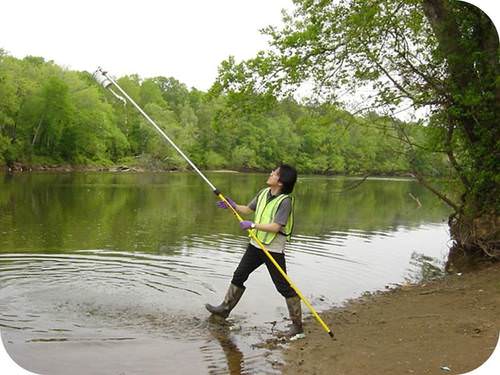1.21 实地研究
章节大纲
-
The environmental chemist in this photo is “fishing” for a sample of river water. He works for the US Environmental Protection Agency. He is looking for evidence of pollution in the water.
::这张照片中的环境化学家对河水样本进行“捕捞”,他为美国环境保护署工作,寻找水污染的证据。Science in the Field
::科学领域的实地科学Although are the “gold standard” for scientific investigations, sometimes it’s not possible or desirable to do experiments. Often it’s important to investigate a problem in the real world instead of in a lab. An investigation that gathers evidence in the real world—as the environmental chemist above is doing—is called a field study .
::尽管科学调查的“黄金标准”是科学调查的“黄金标准 ” , 但有时进行实验是不可能的或不可取的。 通常重要的是调查现实世界的问题而不是实验室的问题。 收集真实世界证据的调查 — — 正如上述环境化学家所做的那样 — — 被称为实地研究。Q: Why are field studies important for environmental scientists?
::问题:为什么实地研究对环境科学家很重要?A: To learn about the environment, scientists need to take measurements and make in the real world. This means gathering evidence in field studies; collecting samples of water from a river is one example of this method.
::A:为了了解环境,科学家需要在现实世界中进行测量和制造,这意味着在实地研究中收集证据;从河流中收集水样就是这种方法的一个例子。Case Study: River Water Pollution
::案例研究:河水污染The environmental scientist above will gather samples of river water in several different locations. Then he will take the samples back to a lab to analyze them. He will do tests to identify any pollutants in the samples. Taking samples from different locations may help him identify the source of any pollution he finds. Pollution can enter a river from a single source, such as a waste water pipe from a factory. This is called point-source pollution. Or pollution can enter a river in runoff rainwater that picks up pollutants as it runs over the ground. This type of pollution enters the river everywhere. This is called nonpoint-source pollution.
::上面的环境科学家将在几个不同地点收集河流水的样品。 然后他将把样品带回实验室分析这些样品。 他将进行测试以确定样品中的任何污染物。 从不同地点采集样品可能有助于他查明他发现的任何污染的来源。 污染可以从一个单一来源进入河流, 如工厂的废水管道。 这被称为点源污染。 或者污染可以通过径流雨水进入一条河流, 雨水在地面上收集污染物。 这种类型的污染进入河中无处不在。 这被称为非点源污染 。Q: Assume that the river is polluted only by nonpoint-source pollution. Describe how the samples of river water would compare in terms of the pollutants they contain.
::问题:假定河水仅受到非点源污染的污染,说明河水样品将如何比较其所含污染物。A: All of the samples would contain about the same amount and types of pollutants.
::A:所有样品所含污染物的数量和类型大致相同。Q: How might point-source pollution be identified?
::问题:如何查明点源污染?A: Just one sample might be polluted. This would be the sample taken at, or just downstream from, the single source of pollution.
::甲:只有一个样本可能会被污染。这将是在单一污染源或下游采集的样本,或只是从单一污染源下游采集的样本。Summary
::摘要-
In a field study, a scientist gathers evidence in the real world instead of in a lab.
::在一项实地研究中,科学家在现实世界而不是在实验室收集证据。 -
Field studies are needed to investigate the environment. An example of a field study is collecting samples of river water to test for evidence of pollution.
::需要进行实地研究以调查环境,实地研究的一个实例是收集河流水的样本,以测试污染的证据。
Review
::回顾-
What is a field study?
::什么是实地研究? -
When is a field study more appropriate than a laboratory experiment? Give an example of a problem that might be investigated with a field study.
::实地研究何时比实验室实验更合适?请举例说明一个可以通过实地研究来调查的问题。
Resources
::资源 -
In a field study, a scientist gathers evidence in the real world instead of in a lab.
